Topic: Inferred Properties Of Earth Interior
Inferred Properties Of Earth Interior
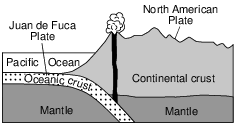
(Not drawn to scale)
Compared to the crust of the North American Plate, the crust of the Juan de Fuca Plate is
(1) thicker and less dense
(2) thicker and more dense
(3) thinner and less dense
(4) thinner and more dense
The pressure at the interface between Earth’s outer core and inner core is inferred to be
(1) 0.2 million atmosphere
(2) 1.5 million atmospheres
(3) 3.1 million atmospheres
(4) 3.6 million atmospheres
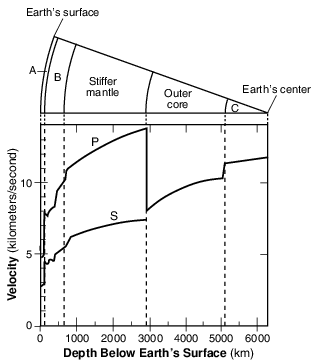
Which layers of Earth’s interior are represented by letters A and B?
(1) A is the crust and B is the rigid mantle.
(2) A is the lithosphere and B is the asthenosphere.
(3) A is the asthenosphere and B is the crust.
(4) A is the rigid mantle and B is the lithosphere.
Earth’s interior at a depth of 3500 kilometers is believed to be
(1) liquid at a temperature of approximately 4900°C
(2) solid at a temperature of approximately 4900°C
(3) liquid at a temperature of approximately 5400°C
(4) solid at a temperature of approximately 5400°C
The diagram below represents a model of Earth’s surface and internal structure. Letters A, B, C, and D represent four different layers. Some depths below Earth’s surface are shown.
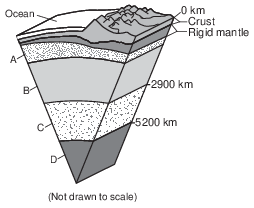
Which Earth layer is inferred to be composed of solid nickel and iron?
(1) A
(2) B
(3) C
(4) D
Earth’s crustal bedrock at the Mid-Atlantic Ridge is composed mostly of
(1) basalt, with a density of 2.7 g/cm3
(2) basalt, with a density of 3.0 g/cm3
(3) granite, with a density of 2.7 g/cm3
(4) granite, with a density of 3.0 g/cm3
The cross section below represents several rock units within Earth’s crust. Letter A represents Earth’s surface. Letters B, C, and D indicate boundaries between rock units. One of the unconformities is labeled.

Which lettered boundary is most likely another unconformity?
(1) A
(2) B
(3) C
(4) D
In which Earth layer does the pressure reach 3.5 million atmospheres?
(1) crust
(2) stiffer mantle
(3) outer core
(4) inner core
What is the inferred pressure, in millions of atmospheres, in Earth’s interior at a depth of2900 kilometers?
(1) 1.4
(2) 9.9
(3) 3.0
(4) 4900
Most ozone is found in a region of Earth’s atmosphere between 10 and 20 miles above Earth’s surface. This temperature zone of the atmosphere is known as the
(1) thermosphere
(2) mesosphere
(3) stratosphere
(4) troposphere
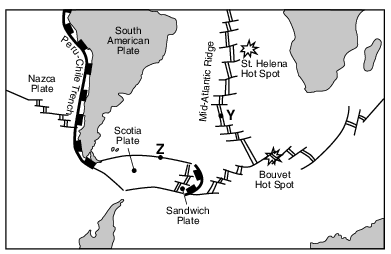
The cross section in the image provided represents a portion of Earth’s interior beneath point Y. On this cross section, draw an arrowhead on each of the four bold lines, to represent the direction of the convection currents in the asthenosphere. [1]
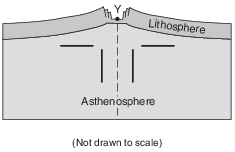
Allow 1 credit for four arrowheads/arrows that indicate rising currents and a divergent movement in the asthenosphere.
• Example of a 1-credit response:
• 
•
• Note: If additional arrowheads or arrows are drawn, all must be correct to receive credit.
• If a student draws his/her own arrows, all arrows must indicate a correct rising and diverging movement.

State the average density of the continental crust of the North American Plate and the average density of the oceanic crust of the Pacific Plate. [1]
North American Plate continental crust: ____________ g/cm3 Pacific Plate oceanic crust: ____________ g/cm3
Allow 1 credit if both responses are correct.
• North American Plate continental crust: 2.7 g/cm3. Pacific Plate oceanic crust: 3 or 3.0 g/cm3

State the pressure and temperature of Earth’s interior at the depth indicated by point A on the graph. [1]
Pressure:
°C Interior temperature:
Allow 1 credit if both responses are correct.
• Pressure: any value from 0.7 million atmospheres to 0.9 million atmospheres.
• Interior temperature: any value from 4100°C to 4300°C.
Columbia River Basalts
The Columbia River Basalts are a formation of several horizontal lava fl ows from eruptions that took place between 6 million and 17 million years ago. These fl ows covered a portion of the northwestern United States. The lava erupted from cracks in Earth’s surface and fl owed westward toward the Pacifi c Ocean. These horizontal basalt layers are currently about 1200 meters above sea level. The lava was created when the North American Plate moved over a mantle hot spot.
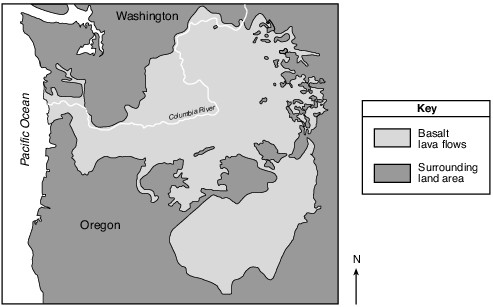
The mantle plumes that created the lava fl ows of the Columbia River Basalts are inferred to have risen from the boundary between the stiffer mantle and the outer core. Identify the interior temperature and depth at this boundary. [1]
Interior temperature: ______________ °C Depth: ______________ km
Allow 1 credit if both responses are correct.
• Interior temperature: any value from 4850°C to 5000°C
• Depth: any value from 2850 to 2950 km

Some of the magma at the Galapagos Hot Spot is believed to originate 1000 kilometers below Earth’s surface. What is the approximate temperature of Earth’s interior at that depth? [1]
°C
Allow 1 credit for any value from 3100°C to 3300°C.
